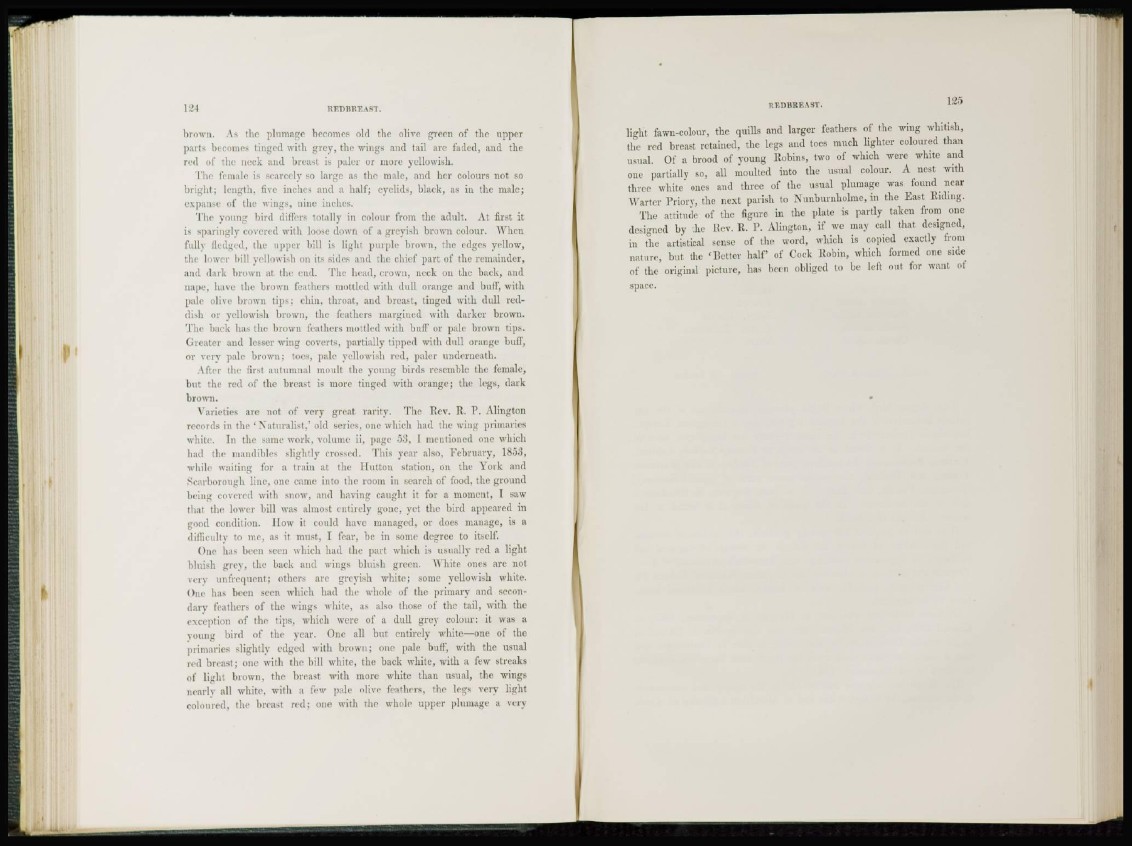
brown. As the plumage becomes old tbe olive green of the upper
parts becomes tinged with grey, the wings and tail arc faded, and the
red of the neck and breast is paler or more yellowish.
The female is scarcely so large as the male, and her colours not so
bright; length, five inches and a half; eyelids, black, as in the male;
expanse of the wings, nine inches.
The young bird differs totally in colour from the adult. At first it
is sparingly covered with loose down of a greyish brown colour. When
fully fledged, the upper bill is light purple brown, the edges yellow,
the lower bill yellowish on its sides and the chief part of the remainder,
and dark brown at the cud. The head, crown, neck on the back, and
nape, have the brown feathers mottled with dull orange and buff, with
pale olive brown tips; chin, throat, and breast, tinged with dull reddish
or yellowish brown, the feathers margined with darker brown.
The back has the brown leathers mottled with buff or pale brown tips.
Greater and lesser wing coverts, partially tipped with dull orange buff,
or very pale brown; toes, pale yellowish red, paler underneath.
Alter the first autumnal moult the voung birds resemble the female,
but the red of the breast is more tinged with orange; the legs, dark
brown.
Varieties are not of very great rarity. The Rev. R. P. Alington
records in the ' Naturalist,' old series, one which had the wing primaries
white. In the same work, volume ii, page 53, 1 mentioned one which
had tin' mandibles slightly crossed. This year also, February, 1853,
while waiting for a train at the llutton station, on the York and
Scarborough line, one came into the room in search of food, the ground
being covered with snow, and having caught it for a moment, I saw
that tin1 lower bill was almost entirely gone, yet the bird apjieared in
good condition. How it could have managed, or does manage, is a
difficulty to me, as it must, I fear, be in some degree to itself.
One has been seen which had the part which is usually red a light
bluish grey, the back and wings bluish green. AVhite ones are not
very unfrequent; others are greyish white; some yellowish white.
One has been seen which had the whole of the primary and secondary
leathers of the wings white, as also those of the tail, with the
exception of the tips, wdiich were of a dull grey colour: it was a
young bird of the year. One all but entirely white—one of the
primaries slightly edged with brown; one pale buff, with the usual
red breast; one with the bill white, the back white, with a few streaks
of light brown, the breast with more white than usual, the wings
nearb all white, with a few pale olive frnthers, the le^s very light
Coloured, the breast red; one with the whole upper plumage a very
light fawn-colour, the quills and larger feathers of the wing whitish,
the red breast retained, the legs and toes much lighter coloured than
usual. Of a brood of young Robins, two of which were white and
one partially so, all moulted into the usual colour. A nest with
three white ones and three of the usual plumage was found near
Warter Priory, the next parish to Nunburnholme, in the East Riding.
The attitude of the figure in the plate is partly taken from one
designed by the Rev. R. P. Alington, if we may call that designed,
in the artistical sense of the word, which is copied exactly from
nature, but the 'Better half of Cock Robin, which formed one side
of the original picture, has been obliged to be left out for want of
space.